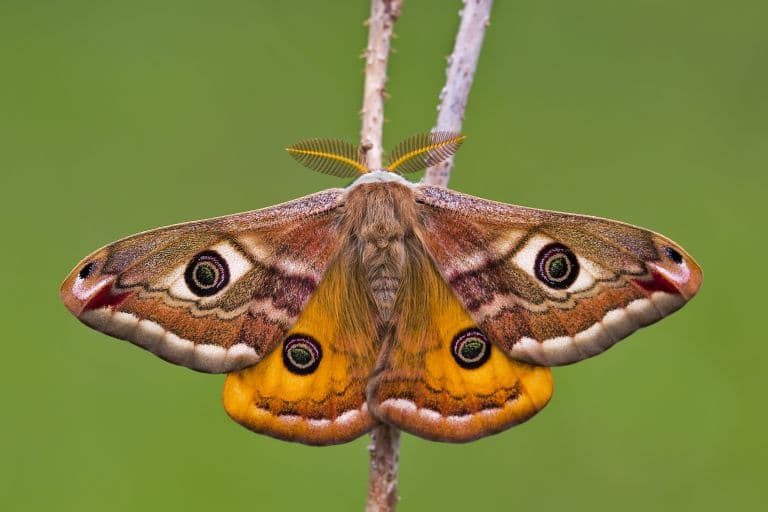Butterflies and moths make up the order Lepidoptera – one of the most diverse orders of animals on the planet. Of all the organisms known to science, roughly 10% exist inside this order, and there are likely far more yet to be described.
It’s the second-largest order after beetles (though you do have to assume some selection bias, because people tend to enjoy studying butterflies more than, say, spiders), and this remarkable diversity means there are a lot of rules and a lot of exceptions.
Butterflies and moths are very similar, but there are a few key differences that you can use to tell them apart.

Let’s find out the differences between butterflies and moths.
1. Moths are nocturnal
This is one rule with a lot of exceptions. There are nocturnal butterflies and diurnal moths, but they are in the minority. The Hedylidae family of butterflies is the only such known to be nocturnal and the Sesiidae family of moths is one of a handful of families known to do their business during the day.
But, on the whole, if you see something fluttering around in the daytime, it’s likely to be a butterfly. Conversely, moths are more likely to be working the night shift, so all those silly things banging into your face when you go out with a head torch are likely to be moths.
2. Butterflies don’t protect their abdomens
Again, this isn’t a hard and fast rule, but if you see a candidate covering its abdomen with its wings, it’s much more likely to be a moth.
This rule doesn’t work in reverse, however; moths often lay their wings flat or hold them up and together just like butterflies do. It’s just much rarer for a butterfly to make a protective tent with its wings – that’s definitely a moth thing.
3. Moths are fatter
Moth bodies are generally plumper and furrier than those of the butterflies. They also have more hair on their bodies, and their wings are thicker.
Altogether, moths are a lot chunkier, in general, than the relatively delicate butterflies. But they’re still not exactly robust. Perhaps it’s unsurprising then, that moths are generally heavier than butterflies.

4. Moths are heavier
This is exemplified perfectly when comparing the largest butterfly to the largest moth. The Queen Alexandra birdwing has an incredible 28cm wingspan in particularly large specimens. It’s possibly the largest lepidopteran on Earth.
This one weighs a hefty 12g, but it’s outclassed significantly by the largest moth.
The Atlas moth is more or less the same size – measuring up to 27cm across, yet it weighs a whopping 28g – more than twice as much as the butterfly.
5. Moths are powdery
If you’ve ever caught a moth and been left with glittery dust on you, those are the protective scales that line the wings of the insect and help keep it flying.
Butterflies have these, too, only they’re much finer and don’t usually leave as much residue on you when you pick them up.
In moths, the scales are both coarser and more plentiful, likely as a result of the need to stay warm at night. These scales never grow back, on either butterflies or moths, and once they’re gone, the moth’s days are numbered, so please be careful when handling them. 1
6. Not all moths can fly
Of course, not all moths even have wings in the first place.
The Marion flightless moth is a species of flightless moth endemic to Marion Island in the subarctic zone. But it isn’t the only one. Many moth species have flightless females who sit around and make the males do all the work of finding a mate. The Belted beauty, found in the UK, is one example of this.
There appears to be no record of flightless butterflies, so if you stumble upon such a creature, it likely has to be a moth. 2
7. Moths have thicker antennae
One very key visual difference is the general trend toward feathery antennae seen in moths and not present in butterflies.
Butterflies have longer, more slender antennae with little clubs at the end. Moths often look like they’re carrying a pair of radio antennae in front of their heads.
Both butterflies and moths use these sensory organs to explore their worlds via smell. Butterflies have more visual cues on account of their daytime activity patterns, but moths, who mostly travel at night have a heightened sense of smell and touch that come from a more detailed facial apparatus. 3

8. Moths make good recording studios
Being nocturnal, moths don’t have to face the constant threat of predation by birds.
Unfortunately, while the birds are asleep, an incredible flying mammal takes over that role. Bats hunt and otherwise navigate their dark world using echolocation. They send out a pulse of ultrasound and use their amazing ears to pick up its echo.
While visual animals pick up reflected light, bats pick up reflected sound and form a picture in their minds of the world around them. Moths are a big part of that picture, and form a huge part of their daily meals, but moths have evolved to be less reflective to sound as a result.
If you take a moth’s wing – preferably after it’s finished using it – and later it onto a section of hard surface, you can fire sounds at it too. Some very strange people decided to do this, and they discovered that it can absorb up to 87% of the incoming sound waves, making it great for dampening a recording studio. 4
9. Moths have fuzzy caterpillars
The differences between butterflies and moths can begin long before they’re even butterflies or moths. Butterfly caterpillars are almost always hairless and bald.
But! These being the complicated order of Lepidoptera, this doesn’t work the other way around. Moth caterpillars are frequently bald, too, and often very glamorous, like most hawk moths.
But if you see a fuzzy one, it’s much more likely to be a moth than a butterfly. 5
Final thoughts
So there you have it – butterfly versus moth!
Moths and butterflies are generally easy to tell apart but the sheer diversity of the order means there’s always going to be an uncomfortable margin of error.
On the whole, moths are nocturnal, stocky, dusty insects with feathery antennae; butterflies are more elegant, diurnal and less scaly, with skinny antennae.
Moths usually hold their wings over their abdomens or flat against the surface they’re sitting on. There are even some moths that have no wings at all. Butterflies can often be seen holding theirs clasped behind their backs or out to the sides to show off their eye spots.
Both come from caterpillars – moths from fussy (and sometimes smooth) ones, and butterflies only from smooth ones. Why we abandon our disgust toward them when these grubs grow wings and flap about in our faces remains a mystery.
Fact Sources & References
- https://www.mccrone.com/mm/butterfly-moth-scales/
- http://microsculpture.net/marion-flightless-moth.html
- https://www.futurity.org/male-moths-antennae-1442972-2/
- https://royalsocietypublishing.org/doi/10.1098/rspa.2022.0046
- https://www.birdsandblooms.com/gardening/attracting-butterflies/insect-moth-butterfly/
